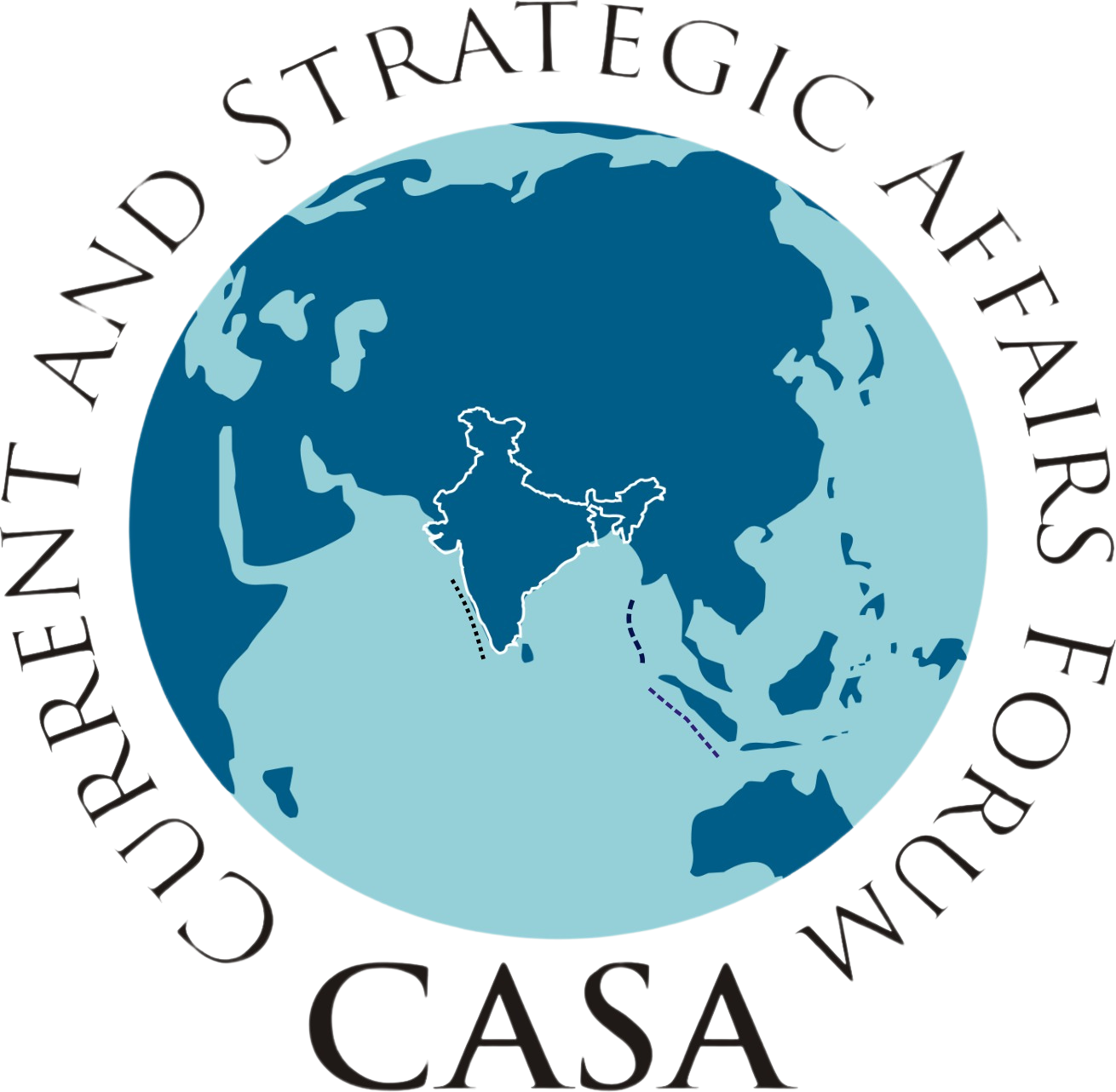THE INCREASING TREND OF ‘NEAR WARS’ AND THEIR IMPACT ON INTERNATIONAL SECURITY
- February 26, 2024
- Posted by: admin
- Categories: Hamas, Israel

Lt Gen Syed Ata Hasnain (Retd)
Even as full-blown wars such as the ones between Russia and Ukraine, and between Israel and Hamas, rage without decisive results, there are many situations around the world which remain poised for war at the pull of a trigger. Strategists and academics call these by all kinds of romantic terms such as proxy wars, hybrid wars, standoffs, low intensity conflicts and even asymmetric situations. Actually, they can all be clubbed together under an umbrella term – ‘Near Wars’. These are wars in the making, of which the international community needs to be always aware and monitoring. They have cascading regional and many times international effects, sometimes quite dramatically and very early. They also provide some great opportunities for trial of new war-fighting technologies without a declared war or a direct physical contact between adversaries. It’s the business interests of many defence manufacturing countries too to see that these situations continue so that a high degree of preparedness is always in existence. There is then the business of information warfare, psychological warfare and strategic communication enabled to a higher degree of proficiency than ever before because of information technology, artificial intelligence and social media. The fact that ‘Near Wars’ are essentially halfway to uninhibited conventional wars, was well realised by China’s People’s Liberation Army (PLA) which led it to bring out the Three Warfare doctrines which primarily spoke of the employment of media, legal and cyber wars as the main methodology of coercion of adversaries while retaining the capability of well equipped, armed and trained forces to step in if warranted; essentially the latter are assigned the role of deterrence and only limited employment in coercion.
The Global Risks Report 2024 published by the World Economic Forum states – “Underlying geopolitical tensions combined with the eruption of active hostilities in multiple regions is contributing to an unstable global order characterized by polarising narratives, eroding trust and insecurity”. Active hostilities actually remain few and far between but festering ‘Near War’ situations abound, along with new threats. Some of these and their degree of danger needs examination.
One of the most dangerous areas for wars in waiting which fester as ‘Near Wars’, is the region of the Pamirs. In all directions from the famous Pamir Knot, exist threats which can generate enough perception of vulnerability or capability. The New Great Game is all about the hunt for establishment of influence in an area which bears great potential for mineral wealth, future energy corridors and routes for access to the warm waters of the Indian Ocean. China has major concerns to build the strength of its influence in Central Asia to stave off the possibility of the advent of extremist Islamist ideology. It fears that the increase of Islamism will have a direct bearing on the integrity of Xinjiang which too houses a large Muslim population. Extremist Islamist groups with bases in Central Asia are ranged against Chinese, Russian and other interests. They have deep linkages with other terror groups in Afghanistan and these networks work hand in glove with drug cartels and arms traffickers, especially with the massive numbers of arms and ammunition in circulation in the region after the US withdrawal from Afghanistan in 2021. China also has its interests in the security of its strategic arteries that form part of the Belt and Road Initiative (BRI), its alternative to sea connectivity. Both China and Russia can be coerced through the Pamir region with constant ideological threats which impinge on the vulnerable populations of the region and in the case of China on its infrastructure too.
Stepping just a little south from the Pamir region is Afghanistan in its new avatar, slowly emerging as a potential threat to its neighbours, chiefly Pakistan. The Taliban is not enthused by just self-rule and perceives that Afghanistan’s ability to defeat numerous empires in the past bestows on it the right to be an aspirant for the leadership of an obscurantist segment of Islam. Saudi Arabia’s apparent stepping aside from the Salafi route, not yet a cemented step, is creating space within the Islamist world and Afghanistan has therefore endeavoured to step up the coercion of a potential competitor Pakistan. The self-created complexities of Pakistan’s borders provide the potential for Afghanistan to strategize in these terms. It has no money for warfighting to achieve any objective, yet calibrating to levels of a ‘Near War’ allows it the leeway to aspire and execute some plans. All this is manifesting at the Durand Line and the sponsored proxies in the form of the Tehreek e Taliban Pakistan (TTP). War may not come for long, or not at all but its lower equivalent festers to keep the region on tenterhooks, until better capability exists.
South Asia has many such locations where extant ‘Near War’ conditions exist, the long border between India and China being one of them. War is least likely here but calibrated standoffs will remain a reality because these are used to communicate capability and bring focus when there are wars elsewhere. A patrol clash in Ladakh just when some action is on in the Indian Ocean Region is a typical ploy. This situation also involves China’s grand strategy to keep India out from being a serious player in the Indian Ocean, although considering recent skirmishes it’s the Indian Navy which is displaying far better capability than any other. The grand strategy perceives that a credible threat by the PLA in the high Himalayas, the continental domain so to say, will effectively keep Indian aspirations in the maritime domain well under check. The events of Apr-May 2020 in Eastern Ladakh and progressively thereafter make amply evident the fact that threats there continue to influence overall security policy; so much for ‘Near Wars’ and the manifestations they bring.
Currently South Asian borders and the entire Middle East are volatile. The Middle East’s main military engagement remains the Israel-Hamas war but there remain connected ones which can erupt with even minor triggers. Although the mood and capability to fight wars hardly exist in populations or leaderships, especially in the post Covid period bracing for war is something which finds greater acceptance as strategy. Hezbollah has been threatening the northern Israeli border but has desisted from direct action except such that is within limits of tolerance. Syria has been subjected to missile strikes without much response and Iran itself has carefully calibrated its own role, never crossing a threshold. The Houthis continue to be spoilers despite huge humanitarian issues in their population which the international community has attempted to overcome. Yet the Houthis are the world’s most effective proxies of the day and could be largely responsible for some of the ‘Near Wars’ of the Middle East.
The most dangerous of all ‘Near War’ situations remain the Indo Pakistan border, including the LoC. That is because of the nuclear backdrop, history of hostilities, festering asymmetric strategy employed by Pakistan and a prevailing tenuous peace brought on by Pakistan’s non achievement of its aims over 35 years. Its current almost derelict economic status is a constraint. However, its blessed geostrategic location gives it the potential of punching above its weight in the international security environment with the US constantly returning to it for engagement. It can help the US coerce India, Russia and China through the stance it adopts from time to time. Its strategic importance is also multiplied due to its Islamic connection. In the recent standoff with Iran, it was broadly surmised that it acted on behalf of the US to respond to Iran’s missile attacks and thus help push in Iran from the east.
Here we have only discussed three potential conflict zones – Central Asia, South Asia and the Middle East. There are many other ‘Near War’ situations which abound the world in other conflict zones such as the Indo pacific and Europe, each having the capability to take a standoff beyond a point of no return. Each is a global risk. However, as the Global Risks Report 2024 states – “alongside global risks and the era-defining changes underway lie unique opportunities to rebuild trust, optimism and resilience in our institutions and societies”. To ameliorate these risks initiatives are required and for that trust is a must. Regular and continuous veto in the UNSC spells mistrust and lack of congruency in resolution of issues. The important thing is that ‘Near War’ situations must be overcome with more resolute commitment and promise against exploiting these. That is the only way that we can proceed to a situation of relative stability; peace is something well beyond.


Lt Gen Syed Ata Hasnain (Retd)
AUTHOR
Lt Gen Syed Ata Hasnain (Retd), PVSM, UYSM, AVSM, SM, VSM* former Commander of Indian Army’s Srinagar Corps, focuses on trans-national and internal conflicts in Asia and the Middle East with particular emphasis on issues revolving around radical Islam. He is the Chancellor of Central University of Kashmir and speaks extensively at Indian and international institutions on a wide variety of subjects revolving around strategic affairs and leadership. He is presently a Member of the National Disaster Management Authority (NDMA).
